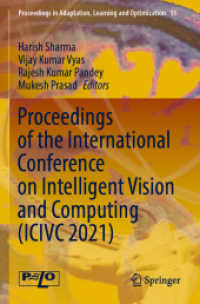- ホーム
- > 洋書
- > 英文書
- > Nature / Ecology
Full Description
This book collates traditional and modern applications of remote sensing in aquatic ecosystem monitoring. It covers conventional assessment methods like sampling, surveying, macroinvertebrates, and chlorophyll estimation for aquatic ecosystem health assessment. Advanced remote sensing technology provides timely spectral information for quantitative and qualitative assessment of water quality, shoreline changes, coral bleaching, and vegetation monitoring. The book covers different types of aquatic ecosystems like wetlands, rivers, lakes, saline, and the brackish lake. It also:
Reviews the latest applications of remote sensing in the monitoring and assessment of aquatic ecosystems
Includes traditional methods like cartography, sampling, surveying, phytoplankton assessment, river interlinking, and chlorophyll estimation
Discusses the application of multi-source data and machine learning in monitoring aquatic ecosystems
Discusses aquatic ecosystem management, services, threats, and sustainability
Explores challenges, opportunities, and prospects of future Earth observation applications for aquatic ecosystem monitoring
The book discusses space-borne, airborne, and drone geospatial data. The parts broadly cover aquatic ecosystem monitoring, vegetation management, advanced modeling practices, and challenges. It is meant for scientists, professionals, and policymakers working in environmental sciences, remote sensing, and geology.
Contents
Part I: General. 1. Introduction - Editorial Message. Part II: Conventional Aquatic Ecosystems Monitoring. 2. Cartographical Techniques For Wetland Delineation. 2. Freshwater Ecosystem Monitoring: Conventional Assessment of Macroinvertebrates. 3. Evaluating Aquatic Ecosystem Health in the Indian River Linking Program: Diatoms and Macroinvertebrates as Biomonitoring Tools. 4. Multiproxy (Calcareous Nannofossil, Benthic Foraminiferal, and Total Organic Carbon) Records from the Eastern Arabian Sea: Implications for Monsoon-Induced Nutrients and Primary Productivity Changes during the Holocene. Part III: Advanced Aquatic Ecosystems Monitoring. 5.Aquatic Ecosystems Monitoring with Remote Sensing Perspective. 6. Monitoring of Water Quality of Asia's Largest Brackish Water System, Chilika Lagoon. 7. Stream Channel Dynamics over Alluvial Fan Systems: An Overview. 8. Mapping Shoreline Changes in Two River Deltas of Greece Exploiting Geoinformation Technologies. 9.Application of Remote Sensing for Monitoring Aquatic Vegetation: A Case Study of Egyptian Coastal Wetlands Using MODIS/Terra Data. 10. Monitoring Coastal Chlorophyll-a Concentration in the Coast of North Africa Using Remote Sensing and Machine Learning. 11. Aquatic Vegetation Species Identification and Mapping Using Multisource Data-Review. 12.Investigation of Seasonal Variability of Chlorophyll-a in the Arabian Sea. 13. Management of Aquatic Ecosystems and Aquatic Vegetation for Environmental Sustainability.14. Potential Fishing Zones Estimation along the Coast of India Using Geospatial Technology. 15.Impact of Climate Change and Land Use Land Cover Dynamics on Wetland Ecosystem in Punjab Using Geospatial Technology. 16. Coral Reefs Threat Assessment and Comparative Analysis of Neil and Agatti Island, India, Using Multispectral Approach. 17. Plastic Pollution Is a Serious Menace to Ecosystem Health with Special Reference to Aquatic Ecosystems and Its Associated Challenges, Opportunities, and Mitigations Part VI Challenges and Future Opportunities in Aquatic Ecosystem Monitoring. 18.Challenges and Future Implications in Monitoring and Assessment of Aquatic Ecosystems.








